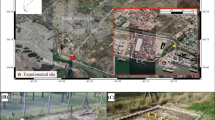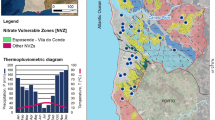Abstract
A modeling study on fertilizer by-products fate and transport was performed in an unconfined shallow aquifer equipped with a grid of 13 piezometers. The field site was located in a former agricultural field overlying a river paleochannel near Ferrara (Northern Italy), cultivated with cereals rotation until 2004 and then converted to park. Piezometers were installed in June 2007 and were monitored until June 2009 via pressure transducer data loggers to evaluate the temporal and spatial variation of groundwater heads, while an onsite meteorological station provided data for recharge rate calculations via unsaturated zone modeling. The groundwater composition in June 2007 exhibited elevated nitrate (NO −3 ) and chloride (Cl−) concentrations due to fertilizer leaching from the top soil. The spatial distribution of NO −3 and Cl− was heterogeneous and the concentration decreased during the monitoring period, with NO −3 attenuation (below 10 mg/l) after 650 days. A transient groundwater flow and contaminant transport model was calibrated versus observed heads and NO −3 and Cl− concentrations. Cl− was used as environmental tracer to quantify groundwater flow velocity and it was simulated as a conservative species. NO −3 was treated as a reactive species and denitrification was simulated with a first order degradation rate constant. Model calibration gave a low denitrification rate (2.5e−3 mg-NO −3 /l/d) likely because of prevailing oxic conditions and low concentration of dissolved organic carbon. Scenario modeling was implemented with steady state and variable flow time discretization to identify the mechanism of NO −3 attenuation. It was shown that transient piezometric conditions did not exert a strong control on NO −3 clean up time, while transient recharge rate did, because it is the main source of unpolluted water in the domain.








Similar content being viewed by others
References
Allen, R. G., Pereira, L. S., Raes, D., & Smith, M. (1998). Crop evapotranspiration. Guidelines for computing crop water requirements. Irrigation and Drainage Paper No. 56. FAO, Rome.
Antonellini, M., Mollema, P., Giambastiani, B., Bishop, K., Caruso, L., Minchio, A. et al. (2008). Saltwater intrusion in the coastal aquifer of the southern Po plain Italy. Hydrogeology Journal, 16(8), 1541–1556. On-line version: http://dx.doi.org/10.1007/s10040-008-0319-9
Appelo, C. A. J., & Postma, D. (2005). Geochemistry, groundwater and pollution (2nd ed.). Rotterdam: Balkema.
Bernot, M. J., & Dodds, W. K. (2005). Nitrogen retention, removal, and saturation in lotic ecosystems. Ecosystems, 8, 442–453.
Bölke, J. K., & Denver, J. M. (1995). Combined use of groundwater dating, chemical, and isotopic analyses to resolve the history and fate of NO3- contamination in two agricultural watersheds, Atlantic coastal plain, Maryland. Water Resources Research, 31(9), 2319–2339.
Burt, T. P., Matchett, L. S., Goulding, K. W. T., Webster, C. P., & Haycock, N. E. (1999). Denitrification in riparian buffer zones: the role of floodplain hydrology. Hydrological Processes, 13(10), 1451–1463.
Cinnirella, S., Buttafuoco, G., & Pirronea, N. (2005). Stochastic analysis to assess the spatial distribution of groundwater NO3- concentrations in the Po catchment (Italy). Environmental Pollution, 133, 569–580.
Cynthia, A., Voelker, M., Lee Brown, M., Roger, M., & Hinson, M. (2002). Preoperatively acquired methemoglobinemia in a preterm infant—Case report. Pediatric Anesthesia, 12, 284–286.
Dorsch, M. M., Scragg, R. K. R., McMichael, A. J., Baghurst, P. A., & Dyer, K. F. (1984). Congenital malformations and maternal drinking water supply in rural South Australia—A case-control study. American Journal of Epidemiology, 119, 474–486.
EEA, European Environmental Agency. (1999). Groundwater quality and quantity in Europe, 123 pp. (http://www.eea.europa.eu/publications/groundwater07012000)
Fan, A. M., & Steinberg, V. E. (1996). Health implications of nitrate and nitrite in drink water: An update on methemoglobinemia occurrence and reproductive and developmental toxicity. Regulatory Toxicology and Pharmacology, 23, 35–43.
Feddes, R. A., Kowalik, P. J., & Zaradny, H. (1978). Simulation of field water use and crop yield. Wageningen: Pudoc.
Fenchel, T., King, G. M, & Blackburn, T. H. (1998). Bacterial Biogeochemistry: the ecophysiology of mineral cycling. Second Edition, Academic Press, ISBN 0-12-103455-0.
Foster, S. S. D. (2000). Assessing and controlling the impacts of agriculture on groundwater—From barley barons to beef bans. Quarterly Journal of Engineering Geology and Hydrogeology, 33(4), 263–280.
Galloway, J. N. (2008). Transformation of the nitrogen cycle: recent trends, questions, and potential solutions. Science, 320, 889–892.
Gelhar, L. W. (1993). Stochastic subsurface hydrology (p. 390). Old Tappan: Prentice-Hall.
Giuliano, G. (1995). Ground water in the Po basin: some problems relating to its use and protection. The Science of the Total Environment, 171, 17–27.
Green, C. T., Puckett, L. J., Böhlke, J. K., Bekins, B. A., Phillips, S. P., Kauff man, L. J., et al. (2008). Limited occurrence of denitrification in four shallow aquifers in agricultural areas of the United States. Journal of Environmental Quality, 37, 994–1009.
Gruber, N., & Galloway, J. N. (2008). An Earth-system perspective of the global nitrogen cycle. Nature, 451, 293–296.
Harbaugh, A. W., Banta, E. R., Hill, M. C., & Mc Donald, M. G. (2000). MODFLOW-2000, The U.S. G. S. modular ground-water model, User guide to modularization concepts and the ground-water flow process, U. S. G. S. Open-file report 00-92.
Hill, M. J., Hawksworth, G., & Tattersall, G. (1973). Bacteria, nitrosamines and cancer of the stomach. British Journal of Cancer, 28, 562–567.
Hofstra, N., & Bouwman, A. F. (2005). Denitrification in agricultural soils: summarizing published data and estimating global annual rates. Nutrient Cycling in Agroecosystems, 72, 267–278.
Höring, H., & Chapman, D. (2004). NO3-s and nitrites in drinking water. In: World Health Organization Drinking Water Series. London: IWA Publishing
Jorgensen, B. B., & Richardson, K. (1996). Eutrophication in coastal marine ecosystems. Coastal and estuarine studies, 52 (p. 273). Washington DC: American Geophysical Union.
Kraft, G. J., Browne, B. A., DeVita, W. M., & Mechenich, D. J. (2008). Agricultural pollutant penetration and steady state in thick aquifers. Ground Water, 46(1), 41–50.
Martin, T. L., Kaushik, N. K., Trevors, J. T., & Whiteley, H. R. (1999). Review: denitrification in temperate climate riparian zones. Water, Air, and Soil Pollution, 111, 171–186.
Mastrocicco, M., Vignoli, G., Colombani, N., & Abu Zeid, N. (2009). Surface electrical resistivity tomography and hydrogeological characterization to constrain groundwater flow modeling in an agricultural field site near Ferrara (Italy). Environmental Earth Sciences Journal. doi:10.1007/s12665-009-0344-6.
Meinardus, H. W., Dwarakanath, V., Ewing, J., Hirasaki, G. J., Jackson, R. E., Jin, M., et al. (2002). Performance assessment of NAPL remediation in heterogeneous alluvium. Journal of Contaminant Hydrology, 54, 173–193.
Nolan, B. T., Hitt, K. J., & Ruddy, B. C. (2002). Probability of NO3- contamination of recently recharged groundwaters in the conterminous United States. Environmental Science & Technology, 36(10), 2138–2145.
Official Journal of the European Communities (1991). Directive 91/676/EEC of the European Parliament and Council Directive of the 12 December 1991 concerning the protection of waters against pollution caused by NO3-s from agricultural sources, 8p.
Official Journal of the European Communities (2000). Directive 2000/60/EC of the European Parliament and Council Directive of the 23 October 2000 establishing a framework for Community action in the field of water policy, 72p.
Ongley, E. D. (1996). Control of water pollution from agriculture: FAO irrigation and drainage. Paper 55: Rome.
Onorati, G., Di Meo, T., Bussettini, M., Fabiani, C., Farrace, M. G., Fava, A., et al. (2006). Groundwater quality monitoring in Italy for the implementation of the EU water framework directive. Physics and Chemistry of the Earth, 31, 1004–1014.
Palmeri, L., Bendoricchio, G., & Artioli, Y. (2005). Modelling nutrient emissions from river systems and loads to the coastal zone: Po River case study, Italy. Ecological Modelling, 184, 37–53.
Pavan, V., Tomozeiu, R., Cacciamani, C., & Di Lorenzo, M. (2008). Daily precipitation observations over Emilia–Romagna: Mean values and extremes. International Journal of Climatology, 28(15), 2065–2079.
Ritchie, J. T. (1972). Model for predicting evaporation from a row crop with incomplete cover. Water Resources Research, 8(5), 1204–1213.
Rivett, M. O., Buss, S. R., Morgan, P., Smith, J. W. N., & Bemment, C. D. (2008). Nitrate attenuation in groundwater: A review of biogeochemical controlling processes. Water Research, 42, 421–4232.
Šimunek, J., Šejna, M., Saito, H., Sakai, M., & van Genuchten, M Th. (2008). The HYDRUS-1D Software Package for Simulating the Movement of Water, Heat, and Multiple Solutes in Variably Saturated Media, Version 4.0, HYDRUS Software Series 3, Department of Environmental Sciences (p. 315). Riverside: University of California, Riverside.
Shomar, B., Osenbrück, K., & Yahya, A. (2008). Elevated NO3- levels in the groundwater of the Gaza Strip: Distribution and sources. The Science of the Total Environment, 398, 164–174.
Spalding, R. F., Exner, M. E., Martin, G. E., & Snow, D. D. (1993). Effects of sludge disposal on groundwater nitrate concentrations. Journal of Hydrology, 142(1–4), 213–228.
Turner, R. E. (1991). Fertilizer and climate change. Nature, 349, 469–470.
Vitousek, P. M. (1997). Human alteration of the global nitrogen cycle: Sources and consequences. Ecological Applications, 7, 737–750.
Ward, M. H., Mark, S. D., Cantor, K. P., Weisenburger, D. D., Correa-Villasenor, A., & Zahm, S. H. (1996). Drinking water nitrate and the risk of non-Hodgkin’s lymphoma. Epidemiology, 7(5), 465–471.
Zheng, C., & Bennett, G. D. (2002). Applied contaminant transport modeling (2nd ed.). New York: Wiley. 621.
Zheng, C., Wang, P. P. (1999). MT3DMS: A modular three-dimensional multispecies model for simulation of advection, dispersion and chemical reactions of contaminants in groundwater systems; Documentation and User’s Guide, Contract Report SERDP-99-1; US Army Engineer Research and Development Center: Vicksburg, MS.
Acknowledgments
The work presented in this paper was made possible and financially supported by the L.A.R.A.-ENVIREN project, under PRITT fund, PARCAGRI (Delib. CIPE n°202) and by the Provincial Administration of Ferrara, within the UE-Water Project of the South-East Europe Program. A special thank to the Fondazione F.lli Navarra which hosted the site and gave detailed information on agricultural practices and to ARPA SIMC for the meteorological data. Dr. Enzo Salemi and Dr. Umberto Tessari are acknowledged for their technical support.
Author information
Authors and Affiliations
Corresponding author
Rights and permissions
About this article
Cite this article
Mastrocicco, M., Colombani, N., Castaldelli, G. et al. Monitoring and Modeling Nitrate Persistence in a Shallow Aquifer. Water Air Soil Pollut 217, 83–93 (2011). https://doi.org/10.1007/s11270-010-0569-8
Received:
Accepted:
Published:
Issue Date:
DOI: https://doi.org/10.1007/s11270-010-0569-8




